Andy Lloyd's
Dark Star Blog 2009
New Scientist asks: Is there a
Planet X?
Serious scientists are once again opening the doors on the
possibility of a Planet X object hiding out there, beyond Neptune:
"Any new object would
have to be well clear of the Kuiper belt to qualify as a planet. Yet
intriguingly, it is studies of the belt
that have suggested the
planet's existence [Planet X]. Some KBOs travel in extremely elongated orbits
around the sun. Others have steep orbits almost at right angles to the orbits of
all the major planets. "Those could be signs of perturbation from a massive
distant object," says Robert Jedicke, a solar system scientist at the University
of Hawaii.
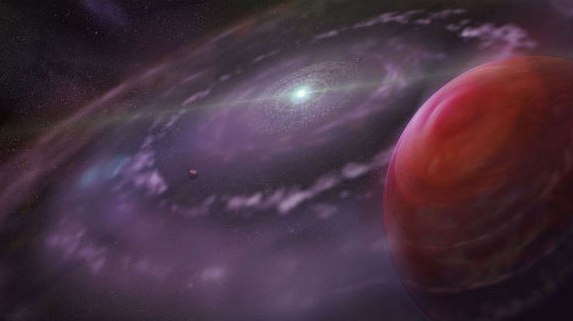
"That is by no means a general
consensus. An early, slow outward migration of the giant planets could also
explain some of these strange KBO orbits - although it has difficulty explaining
all of the belt's observed properties.
"Over the past 20 years, huge
swaths of the sky have been searched for slowly moving bodies, and well over
1000 KBOs found. But these wide-area surveys can spot only large, bright
objects; longer-exposure surveys that can find smaller, dimmer objects cover
only small areas of the sky. A Mars-sized object at a distance of, say, 100 AU
would be so faint that it could easily have escaped detection."
Planet X has been a non-subject for such a long
time within astronomical circles. Indirect evidence for it has been
vehemently challenged in the last few decades. But I sense that this
rear-guard action is softening. Can it be that the evidence is painting an
ever-clearer picture that scientists can no longer ignore?
Written by Andy Lloyd, 1st February 2009
Reference:
Govert Schilling "Is there a Planet X?" 31 January 2009, with thanks to Lee
newscientist.com article
Planet X Conference, Rome 2009
I had a great time at 'The Return of Planet X' conference in Rome during the
weekend of 7th-8th February 2009.
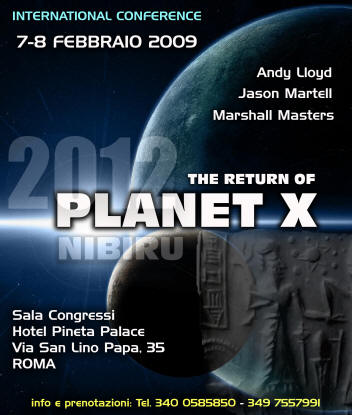
I've put together a blog, complete with
photos, all about the event and the hair-raising events leading up to it:
Andy's review
Roma Planet X
Conference 2009
NASA announce there is (probably) life on Mars
I heard on the BBC news this morning that
NASA will announce today that they have discovered smoking gun evidence for the
existence of life on the red planet. A thin layer of methane has been discovered
in the light Martian evidence. Methane is a chemical that, in nature, is
derived exclusively from biological processes. It cannot be in the Martian
atmosphere solely as a result of geochemical or meteorological conditions.
Therefore, the find heralds the existence of life on Mars.

What form does that life take? Most likely
very simple microbial life known as 'extremophiles', which are capable of
handling the freezing cold conditions on the planet. It was thought that
such life might only be found below the surface of Mars, but recent discoveries
have raised the possibility that water has moved across the Martian surface in
the relatively recent past. So it is plausible that the Martian life might
be nearer to the surface of the planet than originally anticipated.
The finding, if proven, would be a great
step forward for those of us who advocate that life is as routine a feature of
the galaxy as stars and planets. Whether life emerges as a natural event
all over the universe, or is widely spread by comets (panspermia) once it takes
hold, it is everywhere....
Well, the announcement did go ahead, but in typical NASA style, they sat on the
fence. Indicating that there may have been a subterranean volcanic source
for the methane in the atmosphere, they did not offer the conclusion expected by
many commentators - that methane indicated life. But that is surely what
it does mean. NASA seem to be struggling with this fairly simple concept.
What is unclear is ... why? This extract from the Financial Times
(16 January 2009, p6) neatly summarises the likely source of the methane:
"The most interesting possibility is that Mars harbours
"deep bio-communities" that use hydrogen as an energy source and emit methane,
similar to those found 2-3 km below ground in the Witwatersrand basin of South
Africa. They could have been isolated for millions of years from the
inhospitable conditions on the planet's surface."
Just to add fuel to this puzzling fire, now
there's this little gem:
Water dripping on Mars...DRIPPING,
Nasa!....Hello!!
"A series of photographs taken by NASA's Phoenix Lander
show what look like water droplets clinging to one of its landing struts, which
may have splashed up when the spacecraft landed on Mars. Science correspondent
Tom Fielden explains the implications of finding water on the red planet."
Written by Andy Lloyd, 14th March 2009
Reference:
BBC Radio 4, Today " Has water been found on Mars?" 18 March 2009
bbc.co.uk today news
Roman Antiquities 2

Roman
Antiquities 2
A new article by Andy Lloyd brings together
Nibiru symbolism from the early centuries A.D.
Evidence of Shattered World
It was not long ago since a
meteorite sample from Antarctica provided controversial proof of bacterial
development on Mars. Now, scientists are grappling with the possibility
that another couple of meteorites found on the frozen continent might have been
fragments from a shattered world. They contain feldspar, which must have
formed within a substantial dwarf planet, now gone. A high concentration
of sodium also hints at the possibility of a large presence of water on this
dwarf world, which formed along with the other planets some 4.5 billion years
ago.
The question is - what happened to
this world? Was it part of a body that played a pivotal role in the
Celestial Battle of Mesopotamian myth? If nothing else, it is a helpful
reminder of the violence of the early solar system.
Written by Andy Lloyd, 14th March 2009
Reference:
David Shiga,
"Meteorites may be remnants of destroyed dwarf planet", 13 March 2009 with thanks to Lee
newscientist.com article
Hunt for remnants of lost planet
in solar system
Scientists, who are trying to determine whether the Moon formed
after a collision between the early Earth and a Mars-sized planet which
subsequently disintegrated, are searching the Earth's LaGrangian points for
tell-tale signs of its prior existence. Assuming that such a planet once
neighboured the Earth in one of these stable zones, they are using the STEREO
spacecraft to search for small asteroids.
""Their computer models show that Theia could
have grown large enough to produce the Moon if it formed in the L4 or L5
regions, where the balance of forces allowed enough material to accumulate,"
says Kaiser. "Later, Theia would have been nudged out of L4 or L5 by the
increasing gravity of other developing planets like Venus and sent on a
collision course with Earth."
"If this idea is correct, Theia itself is long gone, but some of the ancient
planetesimals that failed to join Theia may still be lingering at L4 or L5.
"The STEREO probes are entering these regions of space now," says Kaiser. "This
puts us in a good position to search for Theia's asteroid-sized leftovers."
Just call them "Theiasteroids."" (1)
Their thinking may or may not be
correct about the prior location of their so-called 'Theia' planet. There
are other possibilities as well - the Planet X scenario being one of them, of
course. But the search indicates the need for such a 'missing' planet to
explain the anomaly of our Moon.
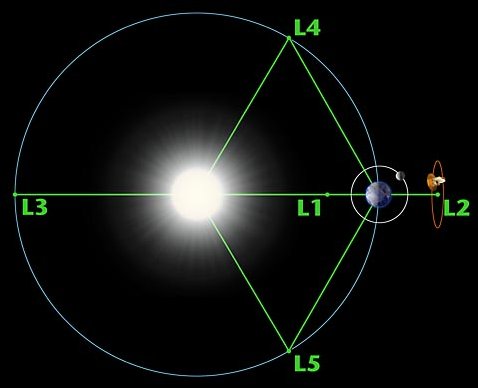
It also highlights the importance of the LaGrangian points.
Every planet has these area in its orbital vicinities. Jupiter's
LaGrangian points are famously host to clusters of asteroids known as Trojans.
If there is a large Planet X body, or Dark Star, then it too will have such
zones which would be potentially stable areas for comet clusters. Think
about the massive extent of the orbit of Nibiru, or the Dark Star. The L3,
L4 and L5 points would make good areas for comets, which might pass through or
near to the inner solar system when the parent body is very remote. In the
case of L3, Nibiru, or the Dark Star, could be at its furthest point from us
when such a cluster along its orbital path pays us a visit. Food for
thought.
Written by Andy Lloyd, 14th March 2009
Reference:
1) "STEREO Hunts for Remains of an
Ancient Planet near Earth" 9 April 2009,
with
thanks to Lloyd Pye
nasa.gov article
Habitable Planets around Dwarf
Stars
There have been a couple of
interesting articles recently about whether life could exist on planets orbiting
red dwarf stars. These small stars are common, but have been traditionally
left out of the debate about life on extrasolar planets. But more
recently, planetary scientists have reconsidered this prior prejudice.
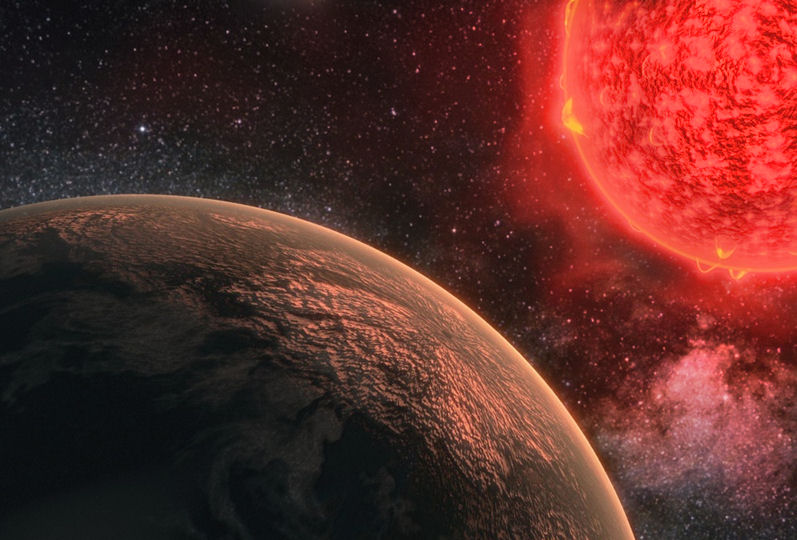
Red dwarfs are much larger than the
Dark Star object I discuss, which is more like the planet Jupiter.
Nevertheless, some of the considerations are interesting, and valid for both
cases. In particular, whether tidally-locked planets around parent dwarf
stars could have reasonable atmospheres (1).
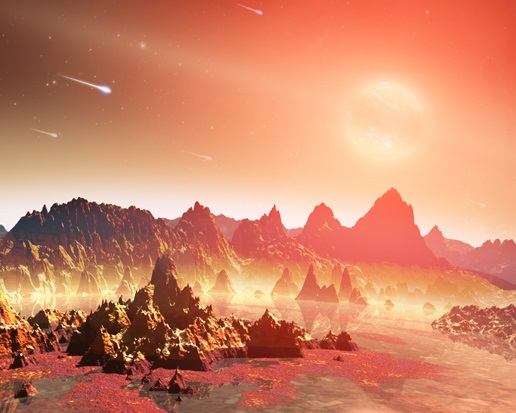
Image credit: NASA/JPL-Caltech
Another point raised by NASA
is that data from protoplanetary disks around red and brown dwarfs shows a lack
of hydrogen cyanide, which might be a problem for the evolution of life in such
systems:
"Observations from NASA's
Spitzer Space Telescope hint that planets around cool stars -- the so-called
M-dwarfs and brown dwarfs that are widespread throughout our galaxy -- might
possess a different mix of life-forming, or prebiotic, chemicals than our young
Earth. Life on our planet is thought to have arisen out of a
pond-scum-like mix of chemicals. Some of these chemicals are thought to have
come from a planet-forming disk of gas and dust that swirled around our young
sun. Meteorites carrying the chemicals might have crash-landed on Earth.
"Astronomers don't know if these same life-generating processes are taking place
around stars that are cooler than our sun, but the Spitzer observations show
their disk chemistry is different. Spitzer detected a prebiotic molecule, called
hydrogen cyanide, in the disks around yellow stars like our sun, but found none
around cooler, less massive, reddish stars. Hydrogen cyanide is a
carbon-containing, or organic compound. Five hydrogen cyanide molecules can join
up to make adenine -- a chemical element of the DNA molecule found in all living
organisms on Earth." (3)
Also of interest is the need for a magnetic field on the
candidate habitable world, which is a function of its spin and size (1).
Written by Andy Lloyd, 11th April 2009
References:
1) Michael Schirber "Can Life Thrive Around a Red
Dwarf Star?" Astrobiology Magazine, 9 April 2009, with thanks to Brian, Pat and David
space.com article
2) Paul Gilster "Prospects for Red Dwarf 'Earths'"
17 March 2009, with thanks to David
centauri-dreams article
3) Whitney Clavin, NASA JPL press release "Cool
Stars Have Different Mix of Life-Forming Chemicals" 7 April 2009, with thanks to Monika
nasa.gov news
Brown Dwarf Discoveries
There has been a rash of discoveries about small
failed stars this week. Some very young (and therefore still hot)
sub-brown dwarfs have been found.
""Finding three candidate
low-mass dwarfs towards IC 348 backs up predictions for how many low-mass
objects develop in a new population of stars. Brown dwarfs cool with age and
current models estimate that their surfaces are approximately 900-1000 degrees
Kelvin (about 600-700 degrees Celsius).
That's extremely cool for objects that have just formed, which implies that they
have the lowest masses of any of this type of object that we've seen to date,""
(1)
Their mass is in the region of
what I expect for our binary Dark Star, although their youth makes them an awful
lot more active as they have not yet used up their fuel.
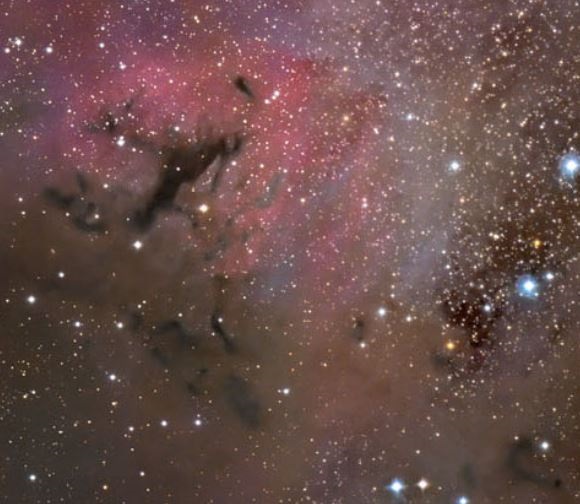
They are not
bound to parent stars, but have formed within stellar nurseries alongside more
traditional suns. Another recent discovery is of a binary object which is
very cool by failed star standards. At just 300 degrees Celsius, Wolf 940B
is clearly an old brown dwarf, weighing in at between 20 and 30 Jupiter masses
(2).
The size and warmth of these
discovered objects is dropping as detection methods improve. But they
remain difficult to find, and old objects of the order of ten Jupiter masses
remain beyond current limits. But it is only a matter of time.
Crucially, brown dwarfs are popping up despite their difficulty to be spotted,
and this may show that they are far more abundant than has been thought, which
may mean that scientists need to revisit their theories of star formation (3).
Written by Andy Lloyd, 24th April 2009
References:
1) "Astronomers
Discover Youngest And Lowest Mass Dwarfs" 22 April 2009,
With thanks to David
spacedaily.com report
2) Anna Salleh "Coolest brown dwarf in universe
found" 20 April 2009,
With thank to David
abc.net.au article
3) New Scientist "'Failed stars' may be common in
our galaxy" 19 April 2009,
With thanks to David
newscientist.com article
The Late, Great Bombardment
Many of my readers will be familiar
with my description of the late, great bombardment. After the formation of
the solar system, there was a volatile period involving planets crashing about,
and at some point very early in the system's history Earth took a hit from a
Mars-sized body. This incredible impact eventually led to the formation of the
Moon.
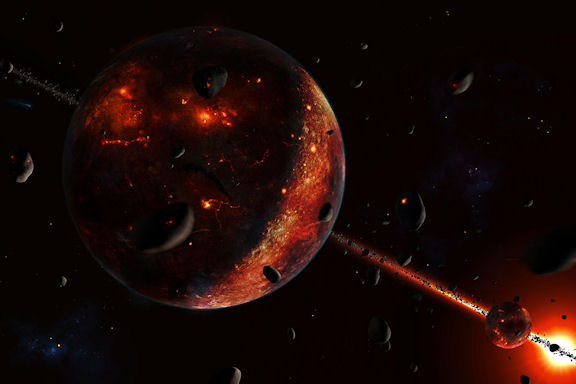
Things quietened down considerably, until a point when the Sun was
over 600 million years old. Then a new series of high impact events
caused mayhem in the inner solar system. This event, some 3.9 billion
years ago, was the Late, Great Bombardment. What created these
catastrophes? Astronomers don't know. I have proposed that this is
the point when the 'Celestial Battle' took place - the advent and close approach
of the Dark Star binary companion and its system of planets.
Whether my explanation is correct or
not, the catastrophe was certainly real enough. Scientists working on this
mysterious period of cataclysm have now found that life might have survived the
multiple asteroid impacts, which would help with the modelling of the emergence
of life on this planet. The extent of the damage to Earth is also
consistent with the damage sustained by 'Tiamat' as described by Sitchin:
Geologic evidence suggests that
life on Earth was present at least 3.83 billion years ago, said Mojzsis. “So it
is not unreasonable to suggest there was life on Earth before 3.9 billion years
ago. We know from the geochemical record that our planet was eminently habitable
by that time, and this new study sews up a major problem in origins of life
studies by sweeping away the necessity for multiple origins of life on Earth.”
Most scientists believe a rogue plan et as large as Mars smacked Earth with a
glancing blow 4.5 billion years ago, vaporizing it self and part of Earth. The
collision would have created an immense vapor cloud from which moonlets, and
later our moon, coalesced, Mojzsis said. “That event, which preceded the Late
Heavy Bombardment by at least 500 million years, would have effectively hit
Earth’s re-set button,” he said.
“But our results strongly suggest that no events since the moon formation were
capable of destroying Earth’s crust and wiping out any biosphere that was
present,” Mojzsis said. “In stead of chopping down the tree of life, our view is
that the bombardment pruned it.”
Written by Andy Lloyd, 25th May 2009
Reference:
"Early
cells might have thrived amid asteroid pummeling" 20 May 2009, article no
longer available, but see:
livescience.com article
Scientific American catches
Dark Star Fever

Scientific American are leading
with this brown dwarf planetary systems article, and accompanying image on the
front of their June 2009 magazine which looks an awful lot like the cover of
'Dark Star'! It's not just the cover either - 'Scientific American'
speculates about the possibility of habitable planets existing around brown
dwarfs, and mentions the potential for such objects to lie hidden between us and
the nearest star. Which is exactly what I've been advocating for some
years.
Scientific American "Unlikely Suns Reveal Improbable
Planets - Astronomers are finding planets where there were not supposed to be
any." June 2009, with thanks to David
scientificamerican.com article
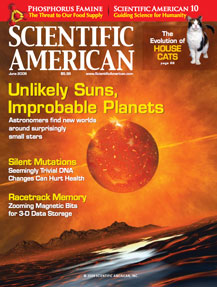

Dark Matter Dark Stars
On occasion people write to me advocating the possibility that a brown dwarf
binary companion might be be constructed by 'electric fields' or plasma. I
generally reply that the Dark Star theory does not require a new theory of
physics to work. A sub brown dwarf built of regular elements would do
nicely. However, there is one intriguing possibility from new physics that
might also fit. Could a Dark Star binary companion be made up of 'dark
matter'? Dark matter is still largely theoretical, but its presence is
required to explain the missing mass of the universe. Given the quantity
of mass missing, is seems likely that it clumps into Dark Stars. It would
also make sense that there are a huge number of low mass stars rather than
extremely massive Dark Matter Stars which might be bending light, and creating
other more noticeable effects. So such a notion would fit with a multitude
of missing low mass companions located at the peripheries of stellar systems.
Here's a piece from 2007 sent to me by my astronomer friend Mattia which
puts just such a possibility across:
"Before stars were fueled by nuclear fusion, they may
have been fueled by dark matter. Researchers have theorized that "Dark Stars"
may have been supported by the huge release of energy from dark matter
annihilation (i.e. the release of energy that comes when matter and antimatter
encounter each other) in the early universe. The physicists from UC Santa Cruz,
UM Ann Arbor, and the University of Utah believe that despite many theories
stating otherwise, dark matter did have an effect on the first stars in the
universe.
"The release of energy from dark matter/anti-dark matter annihilation may have
prevented the first proto-stars from collapsing and beginning fusion, but in
turn could have heated a star¿s core enough to support it. This would change the
time scale of the formation of second generation stars, the appearance of
elements like nitrogen, carbon, and oxygen in our universe, and other aspects of
stellar evolution.
"Products of the annihilation, such as neutrinos, gamma-rays, or antimatter may
make these dark stars or their remnants detectable. Although stars composed of
dark matter are likely to be much dimmer than normal stars, they may produce
some light. The next step for researchers will be to determine how much visible
light the dark stars give off, and how long they survive. Dark stars may have
died out millions of years ago, or they may still exist today.
"The idea of dark stars relies on the Lightest Super symmetric Particle (LSP), a
highly favored candidate for particles that make up dark matter. The properties
of the LSPs are consistent with current information about dark matter in the
universe. Many physicists are hopeful that new experiments in particle colliders
will soon yield more discoveries on the nature of dark matter, and perhaps offer
insight into the possibility of dark stars in the early universe."
Written by Andy Lloyd, 25th June 2009
Reference:
Douglas Spolyar, Katherine Freese, and Paolo
Gondolo "Dark Matter and the First Stars: A New Phase of Stellar Evolution"
Phys. Rev. Lett. 100, 051101, 4 February 2008,
with thanks to Mattia
aps.org/prl abstract
The Asteroid Belt's Twin Origin
Planet X researcher Shad Bolling recently sent me a piece about the complex
origin of the asteroid belt. Apparently, scientists are trying to figure
out why asteroids from the outer asteroid belt vary significantly in composition
from those in the inner asteroid belt.
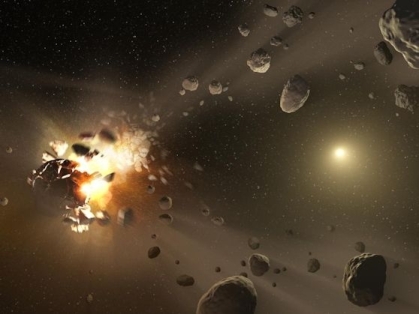
Water ices, and heated processes
demark the two types of asteroid studied by planetary scientists. Writing
in the journal 'Nature', Harold Levison of the Southwest Research Institute in
Boulder, Colorado, advocates the 'Nice Model' to explain how these, and other
anomalies came about. The summary from Space.com makes for fascinating
reading:
"The
Nice model is "a model for the dynamical evolution for the orbits of the giant
planets that we believe was a very violent event that happened roughly 700
million years after the solar system formed," when the solar system was in "its
teenage years," Levison explained. Models haven't been able to reproduce
the formation of Uranus and Neptune in their current orbits, so Levison and
other astronomers think that they formed much closer to Jupiter and Saturn, so
that all the gas giants initially sat within 15 AU of the sun. (One AU, or
astronomical unit, is the mean distance between Earth and the sun, about 93
million miles. Jupiter currently has a mean distance of 5.2 AU from the sun.)
We
think [the gas giant planets] formed in a much more compact configuration than
what we currently see," Levison said. A protoplanetary disk of
planetesimals stretched from just beyond that 15 AU boundary to about 30 AU, the
thinking goes. While this configuration was initially stable, objects
leaking out from the disk caused slow changes in the orbits of the gas giants.
According to the model, about 700 million years after
the solar system formed, these changes resulted in Jupiter and Saturn hitting a
resonance with each other that caused the orbits of Uranus and Neptune to
destabilize. The latter two planets gravitationally scattered off each other
towards Jupiter and Saturn, which pushed back, sending their smaller siblings
out to their current orbits. Like a bowling ball hitting a set of pins,
Uranus and Neptune plowed into the outer protoplanetary disk, whose objects "got
scattered all over the solar system".
(1)
This model might help to explain the late,
great bombardment, and the bizarre distribution of Kuiper Belt Objects. The Nice
model is gaining acceptance in the astronomical community, with its talk of
migrating gas giants, even though it sounds like an unlikely game of planetary
billiards.
The anomalies that the Nice model sets out
to explain also offer rich pickings for Planet X advocates. The
catastrophic element to this period of solar system evolution is
self-explanatory. Add to that the dual nature of the asteroid belt, and
one can piece together events that involve the catastrophic interloping of a
usurper planet. One wonders whether any of the academic researchers who
crunch the numbers in their super-computers have also created models from this
scenario as well? Given the anomalous evidence for an as yet undiscovered
massive planet beyond Neptune, it should surely be a good bet!
Written by Andy Lloyd,
16th July 2009
Reference:
(1) Andrea Thompson
"Migrating
Planets May Have Kicked Asteroids Into Orbit" 15th July 2009, with
thanks to Shad Bolling
space.com article
Telescopes pick out secret spy
satellite

Lloyd Pye sent me an article describing how a secret
satellite deployment was tracked by amateur astronomy sleuths. He noted
how close this was to the storyline in Ezekiel One. Indeed!
Reference:
Justin Ray "Clues about mystery payload emerge
soon after launch" 8 September 2009
spaceflightnow.com article
Is this Nibiru?
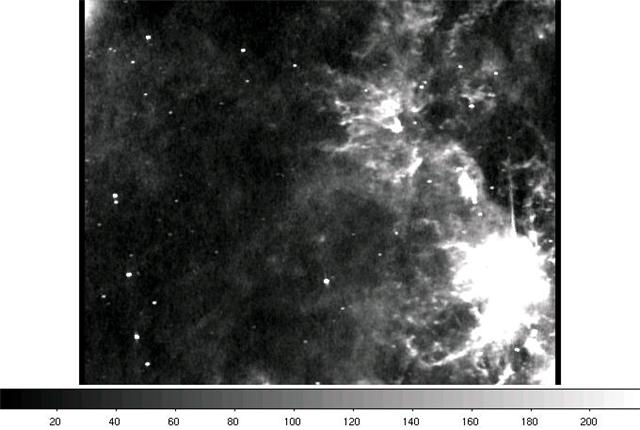
The image is authentic, but what is it of? And where did
this information come from? Visit my new webpage for details:
Nibiru? Candidate object from IRAS database
The LCROSS Mystery
An essential next
step is to establish whether the isotopic ratio for that Moon-water is more like
a planetary object beyond Mars than one at Earth's current location. The
answer to that question would surely have been solved by the planned impacts of
two parts of the LCROSS spacecraft into the lunar surface. NASA expected a
plume of dust and rock to result from the 5,600 mph collision, but there was no
obvious sign of any plume from either collision (7). However, closer
scientific analysis eventually provided exciting news about ice on the Moon:
NASA confirms a "significant
amount" of frozen water
Ice in large quantities on
the Moon has been confirmed by NASA as a result
of the LCROSS mission:
"A
'significant amount' of frozen water has been
found on the moon, the U.S. space agency NASA
said Friday, boosting hopes of eventually
setting up a permanent lunar base. Preliminary
data from a moon probe "indicates the mission
successfully uncovered water in a permanently
shadowed lunar crater," NASA said. "The
discovery opens a new chapter in our
understanding of the moon," it added in a
statement. The data was found after NASA sent
two spacecraft crashing into the lunar surface
last month in a dramatic experiment to probe for
water. One rocket slammed into the Cabeus
crater, near the moon's southern pole, at around
5,600 miles (9,000 kilometers) per hour. It was
followed four minutes later by a spacecraft
equipped with cameras to record the impact." (8)
Robert Massey of the Royal
Astronomical Society speculated that the 'frozen
water' was brought to the surface of the Moon by
comet impacts. (9) The large debris plume rose
at least one or two kilometres in altitude. It
stayed just below the crater rim, which may have
prevented astronomers from observing it from
Earth. (10) Lee Covino, one of my editors, has a
keen interest in data about water sources in the
solar system. He and I agree that the returning
data from comets and asteroid exploration in
recent years has consistently pointed to
anomalies which can be explained by planetary
migration and catastrophism in the early solar
system, involving a Planet X entity. He
points out that the NASA press release about the
LCROSS findings hint at the prevalence of other
volatile materials in the Cabeus crater.
Here are the excerpts themselves:
-
"In addition, water, and other compounds
represent potential resources that could
sustain future lunar exploration."
-
"The concentration and distribution of water
and other substances requires further
analysis, but it is safe to say Cabeus holds
water."
-
"The LCROSS science team along with
colleagues are poring over the data to
understand the entire impact event, from
flash to crater, with the final goal being
the understanding of the distribution of
materials, and in particular volatiles,
within the soil at the impact site."
-
"Along with the water
in Cabeus, there are hints of other
intriguing substances."
(11)
If water was deposited by comets, then there might also be present on the
surface of the Moon organic material from the same source. Given that the
water ice is held within the lunar soil, then it seems reasonable to suppose
that comet-sources organic material and volatiles might also be prevalent within
the lunar soils. Such a discovery would be even more profound than the
confirmation of frozen water. The building blocks of life could be present
within lunar soil, brought to the Moon over billions of years by comets.
All of which begs the question - why was this not realised when
the lunar rocks, returned to Earth by Apollo, were analysed decades ago?
It's perhaps forgivable to mistake water in the lunar soil samples for
contamination. Would missing the presence of organic compounds on the Moon
be an omission too far?
Written by Andy Lloyd, 25th September 2009 - 13th
November 2009
References:
1) Claire Bates "'Now they find water on Mars:
Meteorites uncover ice which could point to life" 27 September 2009
dailymail.co.uk article
2) Lunar Prospector Data Maps Database
3) The Los Alamos Built Spectrometers
Database
4) Lunar Prospector Reduced Spectrometer Data
pds-geosciences.wustl.edu article
5) BBC Radio 4 News, 10pm 24/9/09
6) Andy Lloyd, 'The Dark Star -The Planet X
Evidence', Timeless Voyager Press 2005, see also
darkstar1.co.uk/water.html
7) Ian Sample "Moon Crash Landing Fails to Raise Dust" The
Guardian, 10/10/09, p5
8) NASA "LCROSS finds frozen water on the moon" 13
September 2009
nasa.gov science-news
9) 'P.M.', BBC Radio 4, 13/11/09
10) Jonathan Amos "'Significant' water found on
Moon" 13 November 2009,
includes a video clip of
the LCROSS impact
bbc.co.uk article
11) Jonas Dino, 'LCROSS Impact Data
Indicates Water on Moon' 13 September 2009, with
thanks to Lee
nasa.gov article
Water Anomalies on the Moon - the
implications
NASA's data about Moon rock composition over the last 40
years has been very consistent. The non-polar regions of the Moon are dry,
desiccated, dead. Until yesterday. NASA announced that data from the
Indian
Chandrayaan-1 lunar orbitor indicates that
there is a relative abundance of lunar water - even in areas exposed to the
Sun's rays. At 750 parts per million, a ton of lunar rock would yield
about a litre of water (1). Helpful for future missions.
But, how on earth did NASA get this so wrong
for the last 40 years? The Apollo astronauts brought back piles of Moon rocks,
many of which were analysed for water. Traces were found at the time, but
NASA claimed that "most of the boxes containing the lunar samples leaked
which led scientists to assume traces of water found came from Earth air that
had entered the containers". 750ppm is not a trace. And how about the
boxes which did not leak? What of the water composition in them?
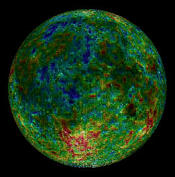
Then
there are the NASA probes in the late 1990s,which deliberately set out to
discover water on the Moon. They found frozen water in deep polar craters.
But Clementine, and particularly Prospector, were set up with spectrometers
capable of detecting water across the surface. How did they miss it?
They certainly shouldn't have! Here's the Mission guidelines for
Prospector's spectrometers:
"Lunar Prospector (LP), which was launched on January
6, 1998, carries an integrated suite of three spectrometers. A Gamma-Ray
Spectrometer (GRS) and a Neutron Spectrometer (NS) are providing global maps of
the major and trace elemental composition of the lunar surface, with special
emphasis on the search for polar water-ice deposits, implied by the H
abundance...Global mapping of elemental abundances by the LP GRS
and NS will impose major new constraints on the bulk composition of the lunar
crust, on compositional variations over the lunar surface, and on the existence
of lunar resources including polar water ice" (2) [my emphasis]
The map opposite shows Prospector data from 1998 (3), which has still not
been properly peer-reviewed over ten years on, according to the PDS website (4).
The equatorial map indicates that a fairly detailed, surface wide analysis was
undertaken. So - it begs the question: Why is the Indian data (and
also Deep Impact data, we learn) so radically different? How is it that 40
years of scientific opinion about Moon soil and rock composition has been so
fundamentally overturned? Did God just pee on the Moon? Or is there
something fundamentally wrong with the data that NASA has been making public for
the last 40 years? The BBC news report about the discovery heard that NASA
scientists were 'very sceptical' about the Indian finding at first, simply
because it so comprehensively overturned their previously held beliefs about
water on the Moon (5).
It beggars belief that two American probes sent to comprehensively survey the
Moon just a decade ago could have come up with the wrong data - wrong data that
is consistent with a scientific belief about the composition of Moon rock dating
back to the 1960s. Are we to believe that in the last decade the Indians
have made a quantum leap forward in technology above and beyond NASA and the
U.S. Department of Defense (which controlled Clementine)? I don't think so.
Notwithstanding that puzzling aspect of this story, there are other implications
for the discovery. Water is common throughout the solar system, it
appears. According to theories of planetary formation in the early solar
system, inner worlds tend to have their water veneers driven off by the strong
solar wind of the young vibrant Sun. This is why Mercury and Venus are
dry, and also why the Moon is supposed to be a desiccated shell. Yet, now
it is clear that the Moon is not that dry at all. If the Moon was formed
by an early collision between the early Earth and a Mars-sized planet, as is
currently accepted, then why does the Moon have this water? It should have been
driven off long ago. NASA argues that this water 'comes and goes' with the
long lunar day - and therefore is part of a continuing chemical process
activated by the Sun's rays.
We return to the great water conundrum that features prominently in my book
'The Dark Star' (6).
Isotopic studies of solar system water are essential to understand the point of
origin of any given water bearing object, as the ratio changes with distance
from the Sun, roughly. This is complicated by collisions with comets which bring
water from the outer solar system. The Earth is a puzzle in this regard, and I
have suggested that this puzzle is best solved by the recognition that Earth
began at a more distant orbital point, and then migrated in to its current
position, perhaps due to a collision. That the Moon still holds quantities
of water in its surface soil and rocks strengthens that point.
Water on Mars
A crater in the equatorial region of Mars has been found to contain exposed
surface ice. That ice appears to be part of an extensive ice sheet which extends
well beyond the polar regions of Mars. The crater was caused by a recent
meteor, and the exposed ice was eventually covered again by Martian surface
dust.
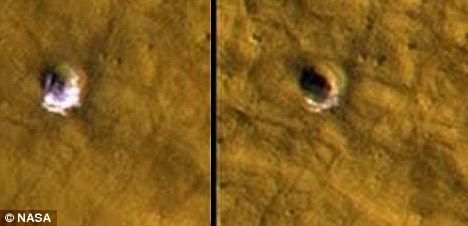
So, it's now established that vast sections of Mars are ice sheets covered in
regolith dust. The ice below the surface is exposed by meteorite impacts, then
quickly covered again by the prevailing dust storms on the red planet. I wonder
whether the extent of the ice below the surface might be even greater still.
Perhaps Mars is more like one of the Gallilean moons of Jupiter. Perhaps not as
obviously ocean-friendly as Europa, but more like Callisto and Ganymede? In
those cases frozen sub-surface ice is gently warmed by the proximity to Jupiter
(the same scenario for a warmed habitable world orbiting a Dark Star). Mars
does not have such a massive companion to warm the sub-surface ice into an
ocean. But...it is large enough to have volcanic activity, as the considerable
calderas on Mars indicate.
Surface features on Mars tend to bat down the idea of active recent vulcanism,
because there are large swathes of ancient craters which should have been filled
in long ago under that scenario. But it certainly seems to be reasonable to
paint a picture of subsurface ice sheets covering Martian oceans warmed by
underground geothermal activity. Meteorite impacts crunching through the
surface ice and releasing underground water might explain some of the Martian
anomalies of dried riverbeds. If the meteorite that uncovered the ice in this
case had been bigger, we might have witnessed just such an effect!
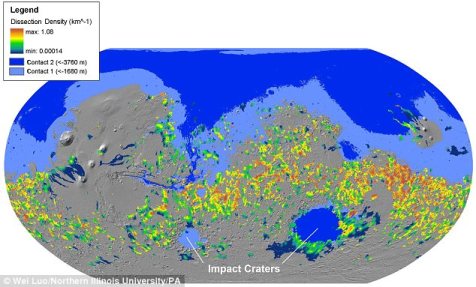
It seems increasingly likely that oceans covered much the of the low-lying
surface of the Northern hemisphere of Mars:
"Computerised analysis of satellite data shows that some
regions of Mars had valley networks almost as dense as those on Earth. 'It is
now difficult to argue against run-off erosion as the major mechanism of Martian
valley networks,' said research leader Professor Wei Luo, from Northern Illinois
University. The belt pattern of the valley network could best be explained if
there was a large northern ocean, said the scientists writing in the Journal of
Geophysical Research - Planets." (3)
That water had to end up somewhere. Could it be that Mars more closely
resembles one of the Galilean moons, with very significant quantities of deep
sub-surface water ice?
Written by Andy Lloyd, 26th September 2009
References:
1) Claire
Bates "Now they find water on Mars: Meteorites uncover ice which could point to
life" The Daily Mail, 25 September 2009, with thanks to Mart
2)
Andrea Thompson,
"Water Ice Exposed in Mars Craters" 24 Sept. 2009,
with
thanks to David
space.com article
3) The Daily Mail "The Red Planet was once blue...
Giant ocean once covered third of Mars" 23 November 2009
dailymail.co.uk article
WISE to Hunt for Dark Star says
JPL
The new Infra-red sky survey telescope is scheduled for launch in mid December
(1). It's
called WISE, and it is a modern and more powerful version of IRAS. It has
the capability of locating numerous brown dwarfs hidden in the constellations.
I've been saying for a long time that WISE is by far the best hope of finding
the Dark Star - a sub-brown dwarf object orbiting the Sun at a great distance.
Now, as WISE launches, a spokesman from the Jet Propulsion Laboratory has
confirmed that looking for a distant Dark Star is actually part of the project's
remit:
"Excitingly, [WISE] may also find a theoretical ninth
planet in our own solar system (since Pluto is no longer counted as a planet,
there are currently only eight). The patterns of comet orbits around our sun
suggests that there may be a huge gas giant planet, about 25,000 times as far
from the Sun as the Earth is, as yet undetected.
"The WISE telescope could spot a Jupiter-sized planet as far as 60,000
Earth-to-Sun-distances (called astronomical units, or A.U.s) from the Sun,
according to one of the scientists behind it, Peter Eisenhardt of NASA's Jet
Propulsion Laboratory in Pasadena, California, and it will be actively looking
for the distant giant." (2)
The idea of a Dark Star was first put forward by Richard Muller et al when they
proposed a distant object that they named 'Nemesis' (3). Lying at the very
periphery of the solar system, among the distant comets in the outer Oort cloud,
Nemesis was thought to be responsible for an observed extinction cycle in the
fossil record. A decade ago, I proposed that this object was located
closer than the astronomers thought - between the Kuiper Belt and the inner Oort
Cloud. Because I don't believe that this object is responsible for an
extinction cycle, I prefer to give it the title 'Dark Star'.
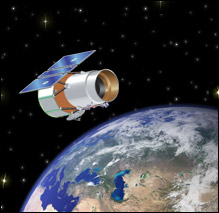
My hypothesis
is that such an object is capable of providing a habitable environment on a
moon/planet in its own planetary system, and thus life, which may be complex -
even intelligent (4). This more positive idea is not in keeping with the
moniker 'Nemesis'. I also believe that this object plays a part in ancient
mythology. Its proximity and irregular orbit may mean that it is
occasionally seen from Earth during rare perihelion events.
Will WISE discovery this Dark Star? If so, will it be found in the outer
Oort Cloud as suggested by Muller? Or will it be found much closer, sweeping out
the empty area beyond the Kuiper Gap, as I have suggested? If WISE does
its job, we will find out in the next couple of years. We are living in
exciting times!
Written by Andy Lloyd, 29th November 2009
References:
1)
http://wise.ssl.berkeley.edu/index.html, with thanks to Craig
2) Tom Chivers "Nasa's Wise telescope
to find brown dwarf neighbours and distant planets" 27 November 2009,
with thanks to David
telegraph.co.uk news
3) Richard Muller "Nemesis: The Death
Star" Weidenfeld & Nicholson 1988
4) Andy Lloyd
'The Dark Star: The Planet X Evidence' Timeless Voyager Press 2005
'The Dark Star: The Planet X Evidence'
Strange meteorites from unknown
asteroid/dwarf planet
Here's a new mystery to consider. Two meteorites, known as GRA 06128 and GRA
06129, were discovered in the Graves-Nunataks region of Antarctica in 2006 (1).
They are unlike any other meteorites. They date almost back as far as the
birth of the solar system, some 4.5 billion years ago.
Scientists are
puzzled by them because they appear to have come from a sizeable object that is
large enough to retain its own heat and so undergo internal melting. This
process, common to planets and moons, causes a differentiation of the rocks and
chemical composition of the body. The mysterious body is likely to be at
least 200 km in diameter, which rules out the vast majority of asteroids.
Here are some of the puzzling aspects of the case:
"Although initial oxygen isotopic compositions are
consistent with an origin in the Earth-Moon system, numerous observations appear
to eliminate both bodies,"
says Chip Shearer of the University of New Mexico (2). So the meteorites
originate from beyond the Earth-Moon system. Additionally, the high sodium
content of the meteorites implies that the body they originated from was rich in
water (3). Yet, it they are inconsistent with Martian meteorites.
Venus seems an impossible fit.
So, the problem is - which body in the solar system did the meteorites come
from, and how did they get here? Our knowledge of the composition of many
planets and asteroids in the solar system is incomplete, and the data we have
from our current collection of meteorites is limited:
"The contemporary flux of meteorites is biased and
unrepresentative of Solar System materials; this is because of the complex
sequence of events required to bring a meteorite from its parent body to Earth.
These biases include, but are not limited to, longevity of the parent body in
the asteroid belt, location of asteroids near dynamically favourable delivery
zones/resonances, impact-excavation and preservation of the meteorite from its
parent body and low-velocity collision with Earth." (4)
It may be that the originating body is one of the larger asteroids, but how did
the asteroid manage to undergo these internal changes so quickly? The
solar system had barely had time to form before these fragments were separated
from their parent body. It has been suggested that the differentiation of
the body was only partial - and that this would allow scientists to square the
circle of the remarkable age of these meteorites against the timeframe needed
for the parent body to properly differentiate (5).
A more radical suggestion has been put forward by Lunar and Planetary Institute
researcher Allain Treiman. He thinks it probable that the source was a
destroyed dwarf planet (6). Under this hypothesis, fragments of the
destroyed world remain in the asteroid belt, awaiting spectroscopic analysis for
verification. We know that the early solar system was a violent place.
We may be closer to understanding some of the detail of that early turmoil.
Written by Andy Lloyd, with research by Lee Covino, 7th December 2009
References:
1) Paul Rincon, "Antarctica's unique space rocks" 13 March 2008
bbc.co.uk article
2) Anne Minard, "Mysterious Meteorites Stymie Scientists" 12
March 2008
sott.net article
3) Lester Haines, "Antarctic meteorite points to smashed dwarf
planet" 13 March 2008
theregister.com
article
4) J.M.D. Day, et al "Making Crust In The Asteroid Belt:
Evidence From GRA 06128/9 And Brachinites" 40th Lunar and Planetary Science
Conference (2009)
lpi.usra.edu
document
5) PhysOrg.com, "Half-baked asteroids have Earth-like crust" 7
January 2009
phys.org news
6) Luke McKinney "Antarctica Yields Fossils of a Destroyed
Dwarf" December 2009, article no longer available online
Astronomers image distant Dark
Star
It may be 50 light years away, but astronomers have succeeded in directly
imaging a brown dwarf companion orbiting the sun-like star named GJ 758 (1).
At least, that's what they think it is. The planet lies at 29 AU
from its parent star (about the same distance as Neptune from the Sun), and is
only 600F - which is a very low temperature for a brown dwarf (2). It may
be as low as 10 Jupiter masses, which would bring it into the category of
sub-brown dwarf. Its distance is proving to be a headache for astronomers:
"The fact that such a large planet-like
object might be orbiting at this location defies traditional thinking on how
planets form, McElwain said. Astronomers think most large planets form either
closer to or farther away from stars, but not in the location where GJ 758 B is
now.
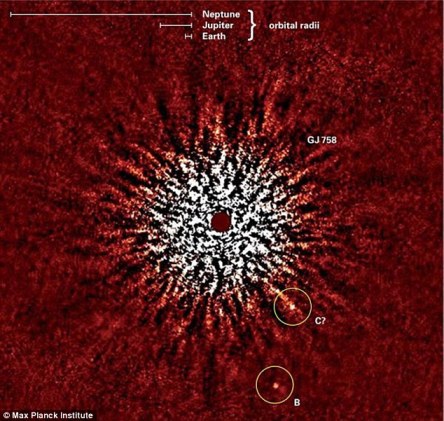
"This challenging but beautiful
detection of a very low mass companion to a sun-like star reminds us again how
little we truly know about the census of
gas giant planets and brown dwarfs around nearby stars," said Alan Boss,
an astronomer at the Carnegie Institution for Science in Washington, D.C., who
was not involved in the research. "Observations like this will enable theorists
to begin to make sense of how this hitherto unseen population of bodies was able
to form and evolve."" (1)

Sun, Earth, Jupiter and a Dark Star
But things may not be quite as they seem:
"Telescope images also revealed a second companion to the
star, which the scientists have called GJ 758 C. More observations, however, are
needed to confirm whether it is nearby or just looks that way. 'It looks
very promising,' said Christian Thalmann, one of the team's lead scientists. If
it should turn out to be a second companion, he said, that would make both of
them more likely to be young planets rather than old brown dwarfs, since two
brown dwarfs in such close proximity would not remain stable for such a long
period of time." (2)
If confirmed, GJ 758 B and C might well bang a further hole in current brown
dwarf theory! Jacco van der Worp makes the excellent point that the
problematic 'Kozai effect' would be an early casualty of such a finding (3).
Let's say that GJ 758 B and C are both confirmed as companions of the parent
star 50 light years away from us. Two brown dwarfs existing within 30AU would
raise major issues about how such a system could have remained stable over any
length of time. This system does not appear to be very young, so it seems
unlikely that the proposed brown dwarf B is in fact a much younger, smaller
light-emitting planet. This appears to be the 'get-out' clause if GJ 758 C was
found to be a companion BD too.
If GJ 758 B and C are both BDs, then the Kozai effect is in
trouble. The implication is that a BD could well move through the solar system
regularly without causing chaos (which was
Hills' judgement back in the
mid-eighties, when the Nemesis concept was explored using supercomputer
models). That would open up the Planet X debate considerably! I'm not saying
that Planet X is here right now, but it would mean that it could have moved
through the solar system in the historical past, as a visible object, without
dismantling the orbits of the other planetary objects.
If a sub-brown dwarf is orbiting around our own Sun (which I believe is the
case, based upon the anomalous evidence of the outer solar system), then it is a
wide binary object that probably currently lies between the Kuiper Belt and the
inner Oort Cloud. Scientists at the Jet Propulsion Laboratory are also
interested in the question of whether a brown dwarf might exist at the edges of
the solar system. A plethora of new telescopes and probes look set to
vastly expand our knowledge of the far-flung reaches of the solar system in the
years to come, starting with the launch of the infra-red telescope WISE (4).
Written by Andy Lloyd, 7th - 11th December 2009
References
1) Space.com staff "First Photo Taken of Object
Around Sun-Like Star, Scientists Say" 3 December 2009, with thanks to Lloyd and
Mike
space.com article
2) Claire Bates "Pictured: First direct image of planet orbiting
a star similar to our Sun" 4 December 2009,
with thanks to Mart
dailymail.co.uk article
3) Correspondence from Jacco
van der Worp, 7 December 2009
4) Alan Boyle
"Hunt for new worlds goes into overdrive" 10 December 2009, with
thanks to Lee
nbcnews.com article
Spanish Researchers claim Dark
Star discovery
I
A group of Spanish scientists have released details of a brown dwarf companion
theory that is eerily reminiscent of the Dark Star theory. I think these
guys wrote to me a while ago, but I had trouble verifying who they were. They
might be putting forward original research that simply corroborates much of what
I've claimed, or they might be relying quite heavily on my prior work.
It's hard to say for sure. They identify the sub-BD (of almost 2 Jupiter
masses) as being in Sagittarius, which I agree with. But at "60AU" this
object is simply way too close. That's only twice the distance of Neptune!
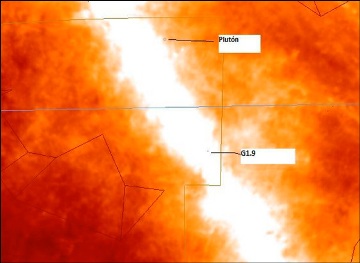
They make the additional claim that the sub-BD, which they name G1.9, is a
celestial object erroneously previously identified as a recent supernova.
Their claim is evaluated on the website viewzone.com:
"G1.9 was first identified
as a "supernova remnant" in 1984 by Dave Green of the University of Cambridge
and later studied in greater detail with NRAO's Very Large Array radio telescope
in 1985. Because it was unusually small for a supernova it was thought to be
young -- less than about 1000 years old. But in 2007, X-ray observations
made with NASA's Chandra X-ray Observatory revealed that the object was much
larger than the last time it was observed! It had grown in size by 16%.
"Puzzled by this
observation, the Very Large Array repeated its observations of 23 years ago and
verified that it had increased in size considerably. Knowing that supernova do
not expand this quickly, unless they have just exploded, they explained that
G1.9 must be a "very young" supernova -- perhaps not more than 150 years old.
But no record of a visible supernova has been found corresponding to that
historical period (about the time of the American Civil War).
"Spanish astronomers
have tracked this object with great interest because they were anticipating its
appearance. Gravitational anomalies have been appearing in the Oort Cloud for
some time, suggesting the perturbations were caused by a nearby object with
considerable mass. The announcement that G1.9 had increased in size was no
mystery to them. It is exactly what they would expect as the object moved closer
to Earth." (1)
The article debunks their claim that the supernova is actually a brown dwarf
star. I also think at that distance we'd have a much better and clearer image
of a spherical brown dwarf object. Saying that, the possibility that a brown
dwarf companion might be a misidentified catalogued object is a good one. It
might not be this particular object, but that's not to say that it might not be
another one in the same vicinity. It would be nice to know who the members
of this Spanish 'scientific research team' are. Perhaps cracks are
appearing in the standard scientific consensus that a brown dwarf companion
object is an impossibility.
Written by Andy Lloyd, 20th December 2009
Reference:
1) Gary Vey, "Spanish Astronomers Claim Dwarf
Sun Beyond Pluto"
viewzone.com/browndwarf.html
Gary Vey's critical investigation into the claims of the 'Starviewer Team'
continues here:
viewzone.com/browndwarf2.html
All articles written by
Andy
Lloyd, 2009,
author of

'The Dark Star'
(2005), 'Ezekiel One'
(2009),
'The Followers of
Horus' (2010),
'Darker Stars' (2019)
Dark Star Blog 2006-7
Dark Star Blog 2008
Dark Star
Blog 2010
Dark Star
Blog 2011
Dark Star
Blog 2012
Dark Star
Blog 2013



























